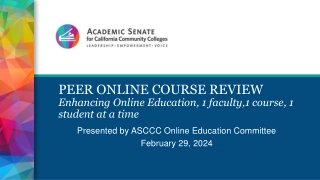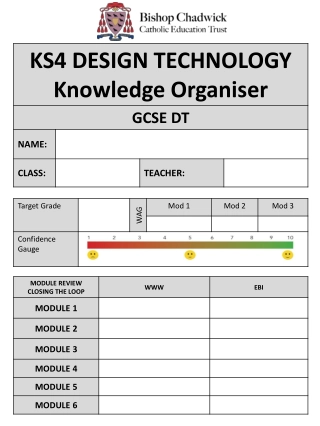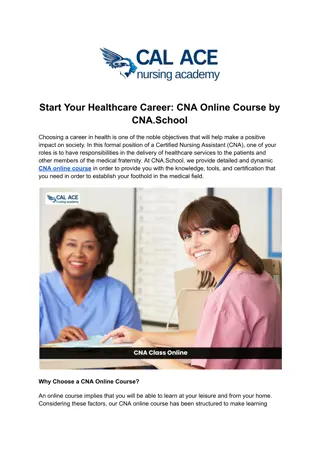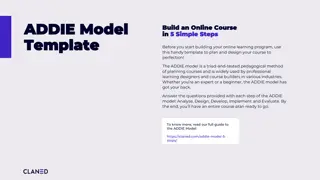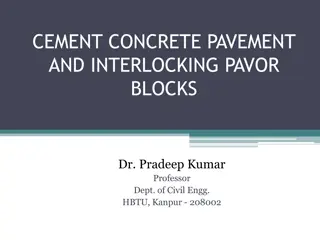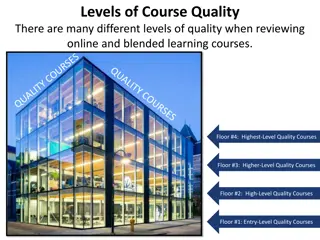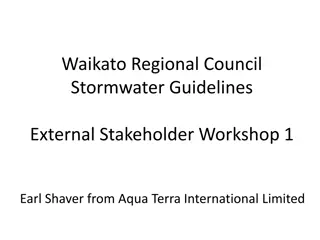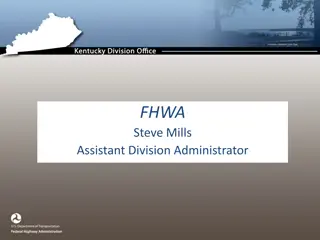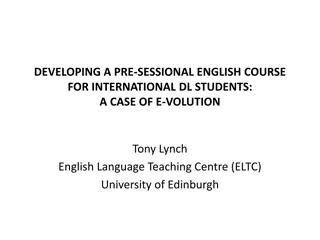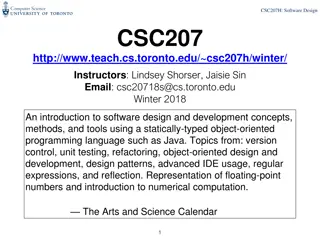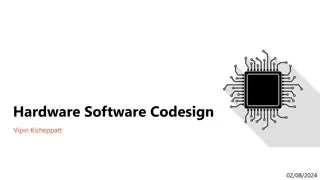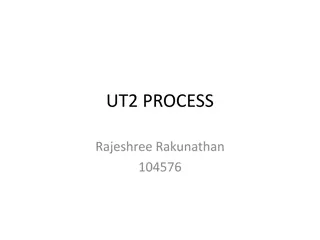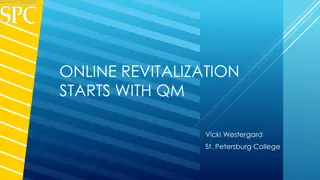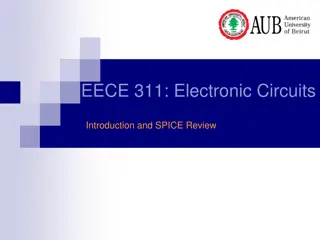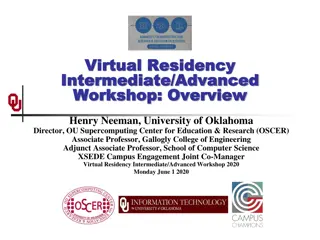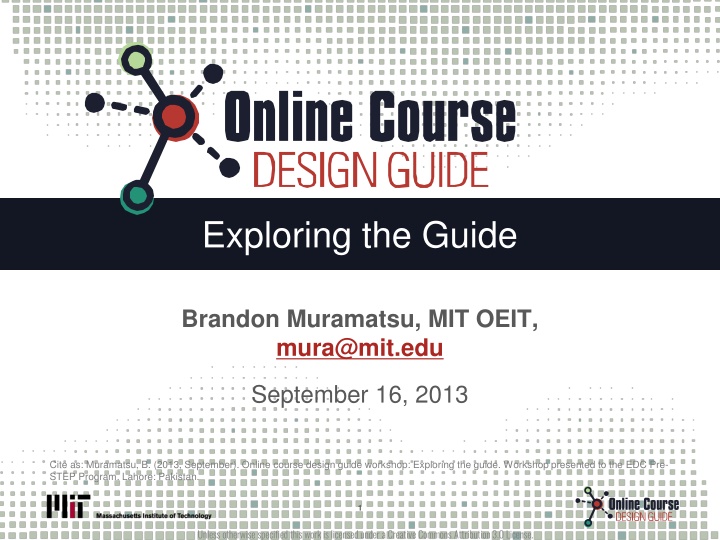
Exploring Online Course Design Workshop with Brandon Muramatsu
Join the workshop with Brandon Muramatsu to explore online course design guidelines and blueprint. Discover the difference between face-to-face and online courses, understand good online facilitation, and create a blueprint for your own online course. Gain insights into educational technology, multimedia design, and open education from an experienced professional. See workshop outcomes and participant interests in developing reflective practices and improving online courses.
Download Presentation

Please find below an Image/Link to download the presentation.
The content on the website is provided AS IS for your information and personal use only. It may not be sold, licensed, or shared on other websites without obtaining consent from the author. If you encounter any issues during the download, it is possible that the publisher has removed the file from their server.
You are allowed to download the files provided on this website for personal or commercial use, subject to the condition that they are used lawfully. All files are the property of their respective owners.
The content on the website is provided AS IS for your information and personal use only. It may not be sold, licensed, or shared on other websites without obtaining consent from the author.
E N D
Presentation Transcript
Exploring the Guide Brandon Muramatsu, MIT OEIT, mura@mit.edu September 16, 2013 Cite as: Muramatsu, B. (2013, September). Online course design guide workshop: Exploring the guide. Workshop presented to the EDC Pre- STEP Program. Lahore: Pakistan. 1 Unless otherwise specified this work is licensed under a Creative Commons Attribution 3.0 License.
Agenda Introduction Overview of the Course Design Guidelines and Blueprint Part 1: Pre-Design Lunch Part 2: Design and Development Part 3: Facilitation Wrap-Up 2 Unless otherwise specified this work is licensed under a Creative Commons Attribution 3.0 License.
Workshop Outcomes Participants will create a blueprint for an online course Participants will understand: The difference between face-to-face and online course What good online facilitation means The importance of learning outcomes 3 Unless otherwise specified this work is licensed under a Creative Commons Attribution 3.0 License.
About Brandon Muramatsu B.S. & M.S. in Mechanical Engineering Taught multimedia design and open education 20 years in EdTech ~10 years in educational digital libraries: Collections, nationwide collaborations, quality and peer review 9+ years in Open Education: Open Educational Resources and OpenCourseWare Been There, Done That Multimedia courseware design and course support, course design, video production software design, digital libraries, metadata, learning objects, open educational resources/OpenCourseWare, 4 Unless otherwise specified this work is licensed under a Creative Commons Attribution 3.0 License.
About you! Please introduce yourselves with your Name and Institution What do you hope to get out of the workshop? 5 Unless otherwise specified this work is licensed under a Creative Commons Attribution 3.0 License.
Participants Interests How to design the online B.Ed. Program Developing online courses to develop reflective practices Have a toolkit to design an online course How to improve existing online courses Software and tools that can be used for online courses 6 Unless otherwise specified this work is licensed under a Creative Commons Attribution 3.0 License.
Participants Interests Elements in the design online courses Practical approaches to launch the courses Framework What kind of digital resources are available What is the digital toolkit and how to use it 7 Unless otherwise specified this work is licensed under a Creative Commons Attribution 3.0 License.
Setting the Stage Have you taken an online course? Have you taught an online course? What courses are you teaching now? 8 Unless otherwise specified this work is licensed under a Creative Commons Attribution 3.0 License.
Setting the Stage Practical skills and how to do it. Why do we need an online course, especially if there s an existing face-to-face course Areas where we can use the toolkit, and the importance of the toolkit Hands on practice to use the toolkit 9 Unless otherwise specified this work is licensed under a Creative Commons Attribution 3.0 License.
Why develop the Guide? 10 Unless otherwise specified this work is licensed under a Creative Commons Attribution 3.0 License.
The Project Rationale: Came from observing the transition from existing courses (especially correspondence / distance learning ones) to contemporary online courses My interest in designing contemporary (for the 21st century) courses that take into account everything we know about good design practice My desire to share the experiences of experts, and their tips and tricks <we re still working on this one> 11 Unless otherwise specified this work is licensed under a Creative Commons Attribution 3.0 License.
The Participants Brandon Muramatsu Tom Caswell Project Lead, MIT OEIT Contributor, Western Governors University Holly Ludgate Marion Jensen Project Lead, New Media Consortium Contributor, American Express Samantha Adams Becker Gretchen Ulrich Writer/Editor, New Media Consortium Contributor, Northeastern University Emily Wray Contributor/Editor/Designer, Full Sail University 12 Unless otherwise specified this work is licensed under a Creative Commons Attribution 3.0 License.
Developing the Guidelines and Toolkit 1.5 Day Meeting Discussed the structure of the guidelines, and goals Draft (write) sections of the guidelines, contribute worksheets and identify resources Edit, edit, edit Unless otherwise specified this work is licensed under a Creative Commons Attribution 3.0 License.
Online Course Design Designing an good online course is designing a good course! 14 Unless otherwise specified this work is licensed under a Creative Commons Attribution 3.0 License.
Part 1: Pre-Design 15 Unless otherwise specified this work is licensed under a Creative Commons Attribution 3.0 License.
Part 1: Pre-Design Gathering all of the necessary information to ensure that the course will meet the needs of the learners and engage them throughout the learning journey. What s different online: More difficult to make spontaneous adjustments The asynchronous nature means you need to be thoughtful about creating interaction opportunities 16 Unless otherwise specified this work is licensed under a Creative Commons Attribution 3.0 License.
Pre-Design Questions (1) you need to make sure you can produce content for their level and the correct voice. Who are my learners? so you can avoid repetition and focus on growing what they have learned. What do they currently know? 17 Unless otherwise specified this work is licensed under a Creative Commons Attribution 3.0 License.
Pre-Design Questions (2) What do they need to know before starting the course? so you can provide prerequisite materials to learners and they can plan accordingly before the course begins. Unless otherwise specified this work is licensed under a Creative Commons Attribution 3.0 License.
Pre-Design Questions (3) curating content you already have means not having to start everything from scratch. What other content is available that supports meeting learning outcomes? being able to identify other resources that support your key topics adds greater depth to the course. Do you have existing material that can be used in the course? Unless otherwise specified this work is licensed under a Creative Commons Attribution 3.0 License.
Pre-Design Questions (4) What content must be revised for an online format or created from scratch? taking inventory of the varying stages of content will inform the design phase and give you a better sense of how much work it will require to prepare the content for online use. Unless otherwise specified this work is licensed under a Creative Commons Attribution 3.0 License.
Going Behind The Curtain Exploring a MIT online course 21 Unless otherwise specified this work is licensed under a Creative Commons Attribution 3.0 License.
MIT and Education MIT does not have a School of Education MIT does have faculty that are deeply interested in education Eric Klopfer (the same faculty member leading the Games and Simulation Course) runs the Scheller Teacher Education Program to prepare MIT students to teach in K-12 schools MIT has a number of central units (TLL, OEIT, etc.) that provide support for teaching and learning. 22 Unless otherwise specified this work is licensed under a Creative Commons Attribution 3.0 License.
Best Practices for Teaching and Learning One of the courses MIT developed for the EDC Pre-STEP program Course Goals: How do we design a course? What are the best methods for promoting critical thinking skills, knowledge retention, and transfer? primarily for in-person classes 23 Unless otherwise specified this work is licensed under a Creative Commons Attribution 3.0 License.
Background on the Course Based on a 14 week course that MIT provides for graduate students and Post-Docs who wish to learn how to teach Course is run by the MIT Teaching and Learning Laboratory (TLL) They work with faculty on education research They work with faculty on pedagogically informed teaching practice Perform some of the functions of a Center for Teaching and Learning 24 Unless otherwise specified this work is licensed under a Creative Commons Attribution 3.0 License.
Background on the Course Instructors have taught the face-to-face version of this course Experienced in teaching in Biology Experienced in research in Biology, both have Ph.D.s Deep interest in biology education, especially preparing students for careers in Biology Instructors have not taught online before Relying on others for that experience <- it takes a team! 25 Unless otherwise specified this work is licensed under a Creative Commons Attribution 3.0 License.
Question: Who are my learners? Faculty interested in learning best practices Challenge: Different from the course upon which it was based Might be in teacher education departments With possible focus on Science / Math education MIT graduate students faculty in teacher education programs 26 Unless otherwise specified this work is licensed under a Creative Commons Attribution 3.0 License.
Question: What do my learners currently know? Unknown Challenge: Might, or might not, have experience with good teaching practice Didn t have the opportunity to really find out about the participants before designing the course, had to make assumptions Might not have been formally trained to teach Unless otherwise specified this work is licensed under a Creative Commons Attribution 3.0 License.
Question: What do my learners need to know before starting the course? Participants should have: Challenge: Didn t have the opportunity to really find out about the participants before designing the course Experience in teaching Perhaps experience in teaching pre-service teachers Had to make assumptions Unless otherwise specified this work is licensed under a Creative Commons Attribution 3.0 License.
Question: Do you have existing material that can be used in the course? Yes! Challenges: Material designed for face-to-face interactions Materials designed for a 14 week course Unless otherwise specified this work is licensed under a Creative Commons Attribution 3.0 License.
Question: What other content is available that supports meeting learning outcomes? Lots and lots Challenge: Pre-supposes learning outcomes! Some materials are referenced in pre- session readings Some materials are referenced during the session videos (as citations) Unless otherwise specified this work is licensed under a Creative Commons Attribution 3.0 License.
Question: What content must be revised or created from scratch? Lecture videos Most of the course is an interactive discussion in class based around the pre- session readings Challenges: Developing a mostly- asynchronous learning experience for what was a highly synchronous course Slides Activities Unless otherwise specified this work is licensed under a Creative Commons Attribution 3.0 License.
Pre-Design Activity Break up into small groups Select a course you teach or would like to teach What s the course title? What s the course about? Answer the pre-design questions Report back 32 Unless otherwise specified this work is licensed under a Creative Commons Attribution 3.0 License.
Pre-Design Questions Who are my learners? What do my learners currently know? What do my learners need to know before starting the course? Do you have existing material that can be used in the course? What other content is available that supports meeting learning outcomes? What content must be revised for an online format or created from scratch? 33 Unless otherwise specified this work is licensed under a Creative Commons Attribution 3.0 License.
Pre-Design: Group 3 Functional English Graduate students 14 years of education Studied English as a subject for 12 years, basic grammar, sufficient vocabulary, comprehension (reading writing, speaking, listening) Basic technology knowledge (IT literacy) Existing materials: textbooks Other materials: British Council online courses, BBC Online Language course, AIOU course What need to be revised, or created? Teacher guides and textbooks Questions: What are the assessments? Test, quizzes 34 Unless otherwise specified this work is licensed under a Creative Commons Attribution 3.0 License.
Pre-Design: Group 1 Child psychology Don t know about philosophy of learning What will they learn about the course Existing materials: Textbooks and course guides Other resources: Other published materials, purchase textbooks online, Wikipedia What is needed: Will need to design for online courses What to revise: Change from print to online 35 Unless otherwise specified this work is licensed under a Creative Commons Attribution 3.0 License.
Pre-Design: Group 4 ICT in Education Audience: Students of B.Ed. Hons. Existing knowledge: Knowledge of basic computers Required knowledge: how to use the Internet and modern technology to access the course Existing materials: Course guide, text material, A/V aids Other materials: Sources from website, e.g., MIT, production center Revision of materials: Assessment system needs to be changed for the online course, textbooks print -> digital, method of teaching and classroom teaching will be revised with videos and assignments 36 Unless otherwise specified this work is licensed under a Creative Commons Attribution 3.0 License.
Pre-Design: Group 2 Classroom Management Audience: undergraduates, 18-20, Men/Women, rural and urban background What do they know: Educational psychology, child development, methods of teaching, awareness of school-based visits, <- Question: is there relevancy for some of these Need to know?: Scheme of studies <- Question is this necessary, Purpose of the course, IT skills Existing Materials: Printed, websites, videos, course guides Other materials: more videos, online simulations / games Revision: study guides, scheme of studies, assessment tasks 37 Unless otherwise specified this work is licensed under a Creative Commons Attribution 3.0 License.
Break 38 Unless otherwise specified this work is licensed under a Creative Commons Attribution 3.0 License.
Part 2: Design and Development 39 Unless otherwise specified this work is licensed under a Creative Commons Attribution 3.0 License.
Part 2: Design and Development In this phase, learning strategies are mapped out, learning content and media are developed, organized, and sequenced, and supporting technology is selected. What s different online: Online learning is more exploratory in nature, and oftentimes less directed than in-person Learners access materials asynchronously: The easier it is for learners to locate and engage with learning activities, the more mental energy they will have to focus on the content. 40 Unless otherwise specified this work is licensed under a Creative Commons Attribution 3.0 License.
Objectives and Outcomes Learning outcomes are general statements that describe the essential learning (knowledge, skills, and attitudes) that learners will achieve by the end of the course. They should encompass the depth of the knowledge and skills that you will be ultimately assessing. When composing outcomes, be mindful not to combine elements that cannot be assessed by a single method. 41 Unless otherwise specified this work is licensed under a Creative Commons Attribution 3.0 License.
Designing a Blueprint What s a blueprint? A comprehensive plan that allows you to design with the big picture in mind to ensure you reach every milestone and build consistency throughout the curriculum. Key Elements Course information Course learning objectives and outcomes Lesson topics and format Learning resources Activities and assessment 42 Unless otherwise specified this work is licensed under a Creative Commons Attribution 3.0 License.
Content Patterns: Organizing & Sequencing (1) Constructing patterns in your curriculum is one way to infuse consistency throughout the course, which helps the learners manage time and resources. How you approach your content each week should be organized in such a way that the learner understands what is being taught and how to interact and engage with the material and community. What s different online: The easier it is for learners to locate and engage with learning activities, the more mental energy they will have to focus on the content. 43 Unless otherwise specified this work is licensed under a Creative Commons Attribution 3.0 License.
Content Patterns: Organizing & Sequencing (2) Write all course content using a consistent voice Create patterns in activity structure (e.g., description, rationale, deliverables, and resources) Establish a consistent schedule (e.g., standardize due dates and plan synchronous sessions, virtual meetings, office hours, and other activities at the same time each week) Align learning objectives to each segment of content Structure the content into smaller pieces 44 Unless otherwise specified this work is licensed under a Creative Commons Attribution 3.0 License.
Best Practices Course: Organizing and Sequencing Example Demo Organizing and Sequencing in Session 1 45 Unless otherwise specified this work is licensed under a Creative Commons Attribution 3.0 License.
Creating Content Relationships Strategically organize and present all course content to leverage the learners existing expertise on a topic against the concepts and skills they are going to learn. 46 Unless otherwise specified this work is licensed under a Creative Commons Attribution 3.0 License.
Best Practices Course: Content Relationship Example Demo Content Relationships in Session 1 47 Unless otherwise specified this work is licensed under a Creative Commons Attribution 3.0 License.
Lesson Development with Media (1) Depending on how you choose to introduce, curate, or present the learning topics, creative applications of media can further engage learners in the material. What s different online: Just posting your slides does not leverage the opportunities in an online course Simply recording a video of an in-person lecture does not leverage the opportunities in an online course 48 Unless otherwise specified this work is licensed under a Creative Commons Attribution 3.0 License.
Lesson Development with Media (2) Media can: Introduce and guide main concepts Generate interest in a subject Reinforce confusing or complex ideas Frame overarching themes Set the stage for an activity Curate a particular approach for how the learner should explore a topic 49 Unless otherwise specified this work is licensed under a Creative Commons Attribution 3.0 License.
Best Practices Course: Media Example (1) Demo Whodunnit Video from Session 1 50 Unless otherwise specified this work is licensed under a Creative Commons Attribution 3.0 License.

